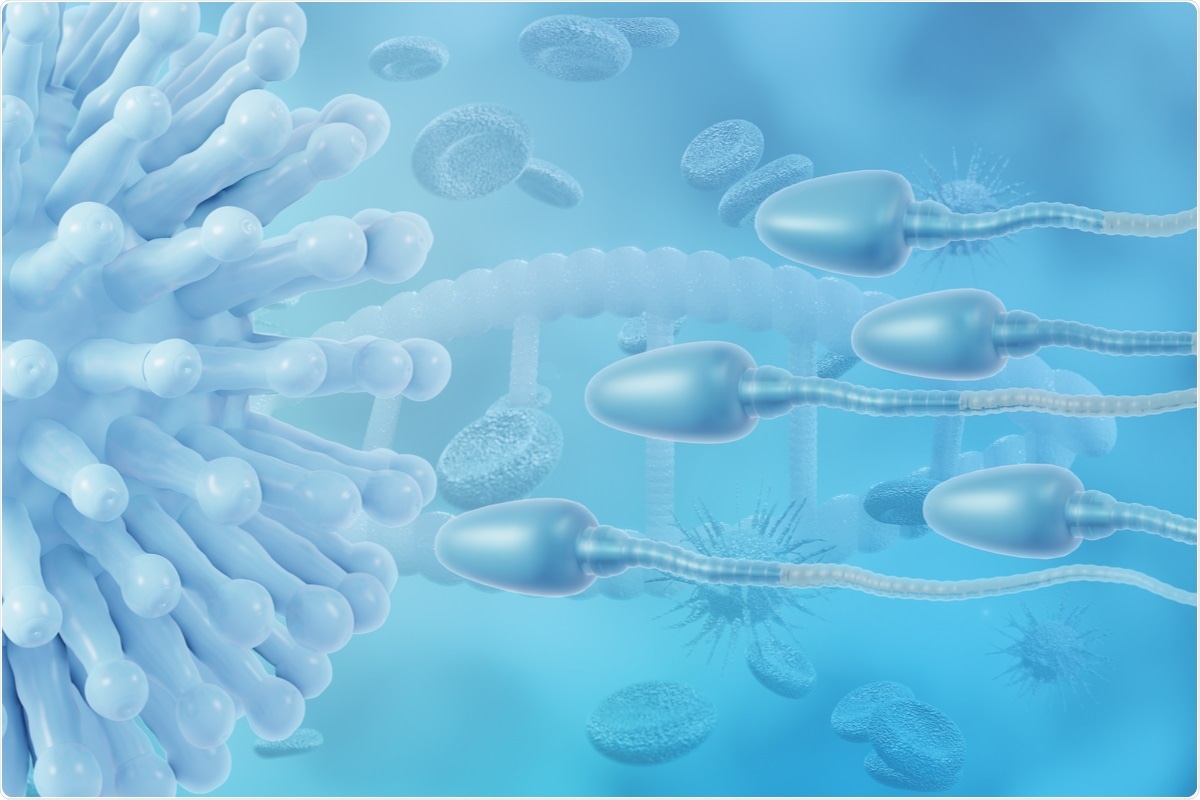The outbreak of the severe acute respiratory syndrome coronavirus type 2 (SARS-CoV-2) has resulted in the ongoing coronavirus disease 2019 (COVID-19) pandemic. SARS-CoV-2 infects human cells by binding its spike glycoprotein to the angiotensin-converting enzyme 2 (ACE2) receptor present on the surface of host cells.
The male reproductive system could be a potential target for SARS-CoV-2, as testicular cells on both sides of the blood-testis barrier express the ACE2 receptor. Furthermore, these cells harbor the entire repository of receptors and ligand-processing enzymes (ACE1 and ACE2) that support the angiotensin signaling cascade.

Study: Sperm quality and absence of SARS-CoV-2 RNA in semen after COVID-19 infection: a prospective, observational study and validation of the SpermCOVID test. Image Credit: Siwakorn TH / Shutterstock.com
The goal of a new study published in Fertility and Sterility was to determine whether SARS-CoV-2 could cross the blood-testis barrier and be detected in human semen after the infection. Furthermore, the researchers were interested in evaluating whether SARS-CoV-2 can negatively affect sperm parameters and fertility.
About the study
This prospective observational trial entailed validation of a SARS-CoV-2 ribonucleic acid (RNA) test system for its detection in semen (SpermCOVID test).
Heeding earlier reports of significant seminiferous tubular injury, reduced Leydig cells, and mild lymphocytic inflammation in the testes of COVID-19 patients, the researchers were also interested in assessing the presence and quantity of SARS-CoV-2 antibody titers in serum and semen after COVID-19. To this end, they hoped that this information would assist them in gauging the role of the immune response in reduced sperm quality.
Study findings
The current study enrolled 120 participants who had recovered from a confirmed SARS-CoV-2 infection. The mean age of the patients was about 35 years, who had a mean body mass index (BMI) was about 25.
Eleven of the study participants were characterized as obese due to a BMI that exceeded 30, while 16 study participants had other comorbidities. Additionally, most participants had no children, and eight reported fertility problems.
The SpermCOVID PCR test did not detect SARS-CoV-2 RNA in any of the 120 semen samples at a mean of about 53 days after their initial COVID-19 diagnosis.
A total of 118 samples were analyzed for semen quality parameters at a mean of 54 days after SARS-CoV-2 infection. The findings revealed that 25% of all samples were oligozoospermic, 44.1% were found to have asthenozoospermia, and two-thirds had teratozoospermia. Notably, sperm morphology was more affected than sperm motility, whereas sperm concentration was least affected.
About one-fourth of the study participants had fully normal sperm parameters. Meanwhile, 25.4% had two abnormal semen parameters including 9 for oligozoospermia and teratozoospermia, 21 with asthenozoospermia and teratozoospermia, and 17.8% had three semen parameters of oligozoospermia, asthenozoospermia, and teratozoospermia.
The majority of clinical parameters or comorbidities recognized as risk factors for severe COVID-19 did not appear to interfere with most sperm quality parameters. However, age was associated with a higher deoxyribonucleic acid (DNA) fragmentation index (DFI) and lower density. Additionally, the severity of infection was associated with a lower motility and morphology score, whereas the symptom of fever or the total symptom score did not impact sperm quality.
Participants elicited a sperm count below 15 million/mL six times more frequently when tested within one month after SARS-CoV-2 infection as compared to when they were tested after two months. Furthermore, a higher number of men yielded less than 32% progressive spermatozoids within the first month after the infection as compared to between one and two months and more than two months after infection.
On the other hand, total motility decreased to less than 40% in a higher proportion of men soon after the infection, as compared to 26% between one and two months and 21% after two months. Contrastingly, sperm morphology does not appear to be affected by time-lapse after COVID-19. However, decreasing mixed antiglobulin reaction (MAR) immunoglobulin G (IgG) and increasing MAR IgA were detected with increasing time lag after the infection.
It was observed that DNA damage of spermatozoa was most pronounced within the first month after COVID-19. Similarly, the mean high DNA stainability (HDS) was greater in the group with short time-lapse than in the groups with intermediate and long time-lapses since infection.
Samples that were tested one month after recovering from SARS-CoV-2 infection were associated with reduced sperm motility, reduced total sperm cells, and lower sperm cell concentration per milliliter. Further, anti-spike 1 and anti-S1-receptor-binding domain (RBD) serum IgG antibodies titers were found to be inversely proportional to sperm motility and cell count.
In 61% of semen samples, IgA anti-sperm antibodies (ASA) were detected. Further, in one participant, the percentage of IgA ASA-positive spermatozoa was above 40%, thereby, indicating immunologic infertility.
In 14 subjects, the percentage of IgA ASA-positive spermatozoa elucidated reduced fertility, whereas IgG ASA was less frequently detected. The global oligo-astheno-teratozoospermia (OAT) severity score strongly correlated to increasing antibody levels.
Conclusions
The findings from the current study provided strong evidence that SARS-CoV-2 cannot be sexually transmitted through sperm after convalescence since none of the semen samples contained viral RNA. However, there were drastic reductions in sperm concentration, the number of spermatozoa, as well as total and progressive motility of the spermatozoa after recovery from COVID-19. Sperm quality parameters became almost normal about two months after the infection, which remained undeterred by the severity of the disease.
The titers of specific anti-SARS-CoV-2 IgG antibodies against the spike and the spike-1-RBD antigens of the virus illustrated a strong correlation with reduced sperm function, thereby indicating an immunologic causality of temporary sperm dysfunction. The reduced sperm quality correlated to increased anti-sperm IgA and IgG antibodies in the semen.
Complete recovery times of semen parameters are still under investigation in a prolonged follow-up study.
Journal reference:
- Donders, G., Bosmans, E., Reumers, J., et al. (2021). Sperm quality and absence of SARS-CoV-2 RNA in semen after COVID-19 infection: a prospective, observational study and validation of the SpermCOVID test. Fertility And Sterility, doi:10.1016/j.fertnstert.2021.10.022.